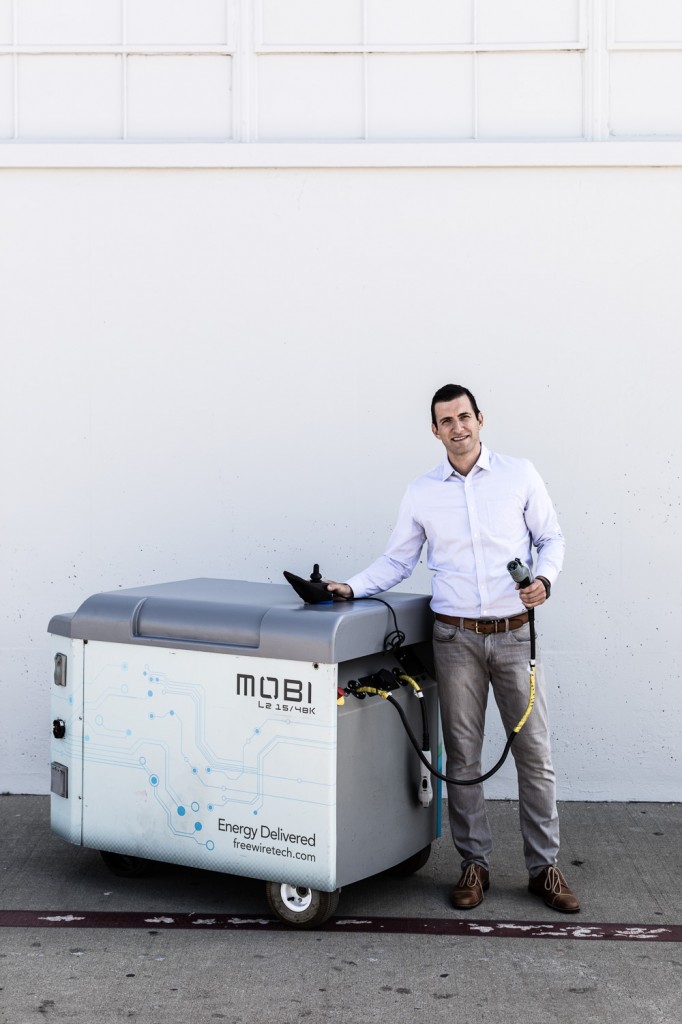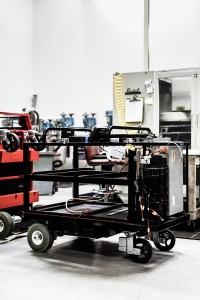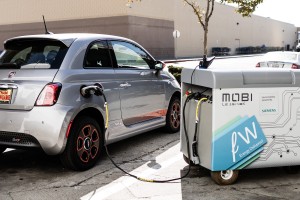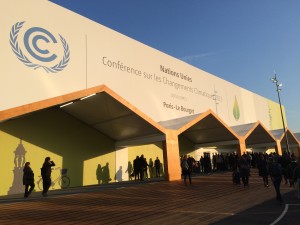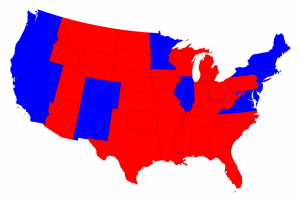 The Trump presidency could have one significant silver lining in the fight against climate change. With most federal action likely to be negative on climate, it will motivate states and cities to take the aggressive action needed to curb emissions through innovation. Gone now is the fiction that the federal government will take the steps necessary to address the full scale of the challenge.
The Trump presidency could have one significant silver lining in the fight against climate change. With most federal action likely to be negative on climate, it will motivate states and cities to take the aggressive action needed to curb emissions through innovation. Gone now is the fiction that the federal government will take the steps necessary to address the full scale of the challenge.
Of course, the Obama administration helped in critical ways, such as through stringent fuel economy standards and boosting investment in solar panels and electric vehicles, among other needed technologies. The Clean Power Plan, likely to be killed soon by Trump’s EPA, was a decent start but not nearly sufficient for what scientists say is needed to avert the worst impacts of climate change. But given federal politics, none of these steps were likely to be sufficient on their own.
So now is a good time for the “coalition of the willing” of states and cities to see what they can do on their own, without the political drag facing federal action. The California-led Under 2 Coalition is a good example of this collaboration at the international level among subnational jurisdictions willing to take strong action.
Here in the U.S., states could do a lot together, such as creating a common carbon market through cap-and-trade, jointly investing in clean technology research, and sharing grid resources to encourage more renewable development at a cheaper cost and with fewer emissions.
But there are constitutional limits to multi-state action. My Berkeley Law colleague Dan Farber describes these limits on Legal Planet, and he remains mostly optimistic about what states can do together while passing constitutional muster:
There are some legalities that have to be observed in designing regional efforts. The biggest issue is whether Congressional consent to a regional agreement is required under the compact clause, which provides that “No State shall, without the Consent of Congress . . . enter into any Agreement or Compact with another State, or with a foreign Power.” This language might seem to require congressional consent to all forms of cooperation between states. Fortunately, the Supreme Court has interpreted the compact clause quite narrowly.
Basically, states want to avoid having to get congressional approval for their multi-state actions, given the negative politics at the federal level. But, as Dan summarizes, as long as states create multi-state programs that aren’t binding on individual states, create superseding regulatory power, or negatively impact federal actions, they can proceed without congressional approval.
It actually gives states lots of leeway, which they should start using as soon as possible.
Repurposing used EV batteries offers the promise of cheap energy storage, which brings significant environmental and economic benefits for customers, ratepayers and utilities. Repurposed EV batteries also have the additional benefit of providing a revenue stream for EV owners and manufacturers, as well as a chance to avoid the environmental impacts from recycling the batteries prematurely.
Freewire Technologies represents one of the leaders in this field, and I had an opportunity this week to visit their office in San Leandro and discuss the future of the business with CEO Arcady Sosinov.
Freewire takes used Nissan LEAF batteries (and other batteries), tests them for quality, and then repackages the battery modules to fit on a mobile unit called the “Mobi” (see photo to the left). The Mobi batteries are wired together and then packaged for delivery.
The initial market for the Mobi was for mobile EV charging, either Level 2 or fast charging (see photo below). Companies with a Mobi give their employees and visitors the option to charge their vehicles without having to move to a fixed charging spot. The company also doesn’t have to trench wiring to install such a charger.
Meanwhile, when the Mobi is re-charging, it can serve as stationary storage to either charge more cheaply at night for daytime dispatch or potentially offset demand charges. At peak times, property owners can dispatch stored electricity in the Mobi instead of pulling more expensive electricity from the grid.
Recently, other companies have purchased Mobis to replace diesel generators, particularly film and television studios that are shooting off-site. The Mobis are cleaner and quieter and have more reliable power. Utilities have also been buying Mobis as distributed storage to ease usage on congested substations. In addition, some cities have purchased them as backup power units in case of power outages that can also provide grid services when plugged in. Even airports have been buying Mobis to charge the onboard electronics on airplanes without polluting generators on the tarmac.
Ultimately, the sky is the limit for the use of these inexpensive, mobile energy storage units. And as thousands of used EV batteries come out of cars in the coming years, the supply increase will bring down costs and lead to even more innovation.
Arcady is currently expanding his business to meet the growing demand and supply, with plans to fill out a much larger space in his building. He’s bullish about the opportunities, particularly with increasing battery supply and growing recognition of the need for cleaner energy sources, particularly in polluted air districts.
Policy barriers definitely remain, as well as questions about how well the batteries will perform in operation over the long term. We detail some of the policy needs in the UC Berkeley/UCLA Law report Reuse and Repower. But as more companies invest in the opportunities, and innovation continues with companies like Freewire, the constituencies and pressure to change outdated laws and regulations that stymie repurposed battery deployment will only grow.
And that’s good news for Freewire and the industry in general, which is poised to be an important part of our energy storage future.
 Energy efficiency probably doesn’t sound too exciting to most people, but saving hundreds of dollars without having to do anything about it probably does. Not to mention reducing pollution and fiscal waste. And that is the legacy of Art Rosenfeld, who passed away last week at the age of 90.
Energy efficiency probably doesn’t sound too exciting to most people, but saving hundreds of dollars without having to do anything about it probably does. Not to mention reducing pollution and fiscal waste. And that is the legacy of Art Rosenfeld, who passed away last week at the age of 90.
Most people have probably never heard of him, but back in the 1970s Mr. Rosenfeld pioneered the idea of energy efficiency standards for new homes and appliances. These standards became law in California and have spread nationwide. As the San Francisco Chronicle obituary reads:
His quest for energy efficiencies led to breakthroughs in a host of areas that affect every person in California: buildings with low-energy electric lights, like compact fluorescent lamps or CFLs; kitchens with low-energy refrigerators; and glass windows that trap heat.
Economists have estimated that those efficiencies have saved Americans countless billions of dollars.
As he pursued his technical efforts, Mr. Rosenfeld also maintained a powerful public focus on persuading utilities and government policymakers that requiring energy-efficient power plants could not only save dollars but would also curb the greenhouse gas emissions that are warming the planet.
I never overlapped with him when he was based at UC Berkeley, but I had colleagues who worked with him and spoke reverently of him and his work. It’s rare to have one person so embody a major field like Rosenfeld did of energy efficiency. His contributions to the environment and all of our pocketbooks are enormous, and we would do well to continue carrying on his legacy and life’s work.
The New York Times offers a good rundown of the various environmental laws and regulations that Trump’s administration will likely attempt to roll back. The upside: many of these agency actions could take years to unwind, likely leaving the final call for efforts like the Clean Power Plan in the hands of the 2020 presidential election winner.
The downside: a number of executive orders, such as preventing coal mining on public lands, can be undone right away. Other rules, like the methane limits on oil extraction, can also be undone by Congress through the Congressional Review Act. And perhaps most significantly, the Trump administration can try to weaken fuel economy standards for automakers, although that too will take time and litigation.
Of course, if Congress can act to weaken the Clean Air Act and other environmental laws, all bets are off. But as long as the filibuster remains in the Senate, that may be hard to do.
Meanwhile, there may be some glimmer of hope on clean technology with the new administration. Trump’s nominee for Treasury secretary backed the production tax credit for wind power (the solar tax credit’s fate may be less certain, and both tax credits could be undermined by broader corporate tax reductions, but still). Tesla/SolarCity CEO Elon Musk also apparently has the ear of Trump on EV manufacturing, which can’t hurt. And while it’s been only a week since the inauguration, Trump hasn’t yet withdrawn the U.S. from the landmark Paris agreement on climate change, while Exxon, incoming Secretary of State Tillerson’s former company, just praised the agreement.
There is still little reason for environmentalists to get their hopes up, and the idea of actually proactively tackling our environmental challenges at the federal level is all but dead for the next four years. But the current legal environment on the environment may be a bit more stable than we might otherwise assume.
 A number of prominent leaders in California’s San Joaquin Valley have opposed policies to combat climate change, in part due to the assumed economic costs on the region. But as our UC Berkeley/Next 10 study released last week shows, those policies are benefiting the regional economy to the tune of over $13 billion.
A number of prominent leaders in California’s San Joaquin Valley have opposed policies to combat climate change, in part due to the assumed economic costs on the region. But as our UC Berkeley/Next 10 study released last week shows, those policies are benefiting the regional economy to the tune of over $13 billion.
Over the weekend, the Sacramento Bee published an op-ed co-authored by me, Betony Jones and Noel Perry. Here’s a highlight passage on the benefits of renewables and cap-and-trade:
Renewable energy projects have brought $11.6 billion in economic activity to the valley. From 2002 to 2015, renewable programs created about 31,000 direct jobs here, as people were hired to build, operate and maintain generating facilities. Another 57,000 jobs were created indirectly, as suppliers and supporting businesses expanded. That’s 88,000 jobs in a part of the state that really needs them.
We also looked at California’s carbon cap-and-trade program, which affects the valley disproportionately because regulated industries are concentrated here. Cap-and-trade auction proceeds have been spent on high-speed rail, affordable housing, irrigation modernization, electric vehicle incentives and other emissions-reducing projects.
After subtracting compliance and other costs of cap and trade, we found direct economic benefits of $119 million and $200 million with indirect benefits included. Once auction proceeds that have been approved but not yet dispersed are spent, the region can expect $1 billion in direct benefits, plus $500,000,000 in indirect benefits. Cap and trade has netted the valley more than 700 direct and 1,600 indirect jobs from 2013 through 2015.
Meanwhile, the report garnered coverage in the Fresno Bee, Turlock Journal, and Valley Public Radio.
I’m glad to see these Valley outlets cover the findings, as residents of the region should be the first to learn of the data we found. The report dispels the common assumption that these environmental policies hurt the local economy. While certain Valley industries incur compliance costs, the deployment of clean technologies and other carbon-fighting programs are providing a much greater offsetting boost.
 Climate policies are under political attack, both in California and nationally. The common argument is that these policies hurt the economy and destroy jobs, particularly in disadvantaged communities.
Climate policies are under political attack, both in California and nationally. The common argument is that these policies hurt the economy and destroy jobs, particularly in disadvantaged communities.
To assess those claims, the Center for Law, Energy and the Environment (CLEE) at UC Berkeley Law and UC Berkeley’s Donald Vial Center on Employment in the Green Economy, working with the nonpartisan nonprofit Next 10, released today the first comprehensive cost/benefit study of climate policies in the San Joaquin Valley, one of California and the nation’s most economically and environmentally vulnerable regions.
The Economic Impacts of California’s Major Climate Programs On The San Joaquin Valley specifically looked at the impact of cap-and-trade, renewable energy, and energy efficiency programs in the eight-county region.
Why the Valley? Simply put, if climate policies can work in this region, they can work anywhere. In addition, the region’s elected leaders have asked questions about the impact of climate policies on their constituents, raising their concerns both in the state legislature and now nationally in the congress.
After examining the data and using advanced modeling software, we found that these three programs (among the most important in California’s suite of climate policies) brought over $13 billion in economic benefits to the Valley, mostly in renewable energy, and created over 31,000 jobs just in the renewable energy sector alone.
With the relatively new cap-and-trade program, we found that despite the compliance costs in the heavily industrial Valley, the benefits from state spending of the allowance auction proceeds outweighed those costs, particularly due to construction of high speed rail, which is funded in part with these funds. Furthermore, once the state disburses proceeds already collected from the auction, those benefits will increase greatly.
The overall benefits to the Valley are likely to continue and grow through 2030, as the state strives to meet its newly legislated climate goals for that year, via last year’s SB 32 (Pavley) and SB 350 (De Leon, 2015). Those efforts will require at least 50% renewables by 2030, a doubling of energy efficiency in existing buildings, and a more robust cap-and-trade program.
However, the benefits of cap-and-trade may cease if litigation over the auction mechanism (described by Ann Carlson at UCLA Law) is successful, as that mechanism allows the state to spend the proceeds that provide the benefits. Furthermore, federal action to undercut renewables and energy efficiency could also slow the gains.
Ultimately though, California is committed to its path and these programs through bipartisan legislation and regulations. Given the economic data we see in this study, its a path that the state should continue — and it can hopefully now inform federal debates about environmental policy and the need for job-producing programs.
You can access the full report via CLEE or Next 10’s websites, and check out partial media coverage in the Los Angeles Times, Central Valley Business Times, and Capitol Public Radio.
 I’d like to think that most human brains can accept data and facts that may not comport with their individual, subjective experience. But that would probably require denying reality, in its own ironic way.
I’d like to think that most human brains can accept data and facts that may not comport with their individual, subjective experience. But that would probably require denying reality, in its own ironic way.
And so it is with climate science, according to a new study in the Proceedings of the National Academy of Sciences journal, as reported by E&E News [paywall]:
People who live in areas where high temperature records are broken are more likely to believe in global warming than those who do not. In areas that experienced record lows, people were less inclined to believe in the mainstream climate science that shows human activity is warming the Earth.
And hence we have a U.S. Senator throwing a snowball on the senate floor as evidence that global warming is a hoax.
Right before the November election, the Real News Network released a 30-minute documentary called “The Doubt Machine: Inside the Koch Brothers’ War on Climate Science.” You can watch it above. It describes how Big Oil, and in particular the billionaire oil tycoons Charles and David Koch, have used their vast wealth and clout to undermine efforts to combat climate change.
The documentary is narrated by Oscar-winning actress Emma Thompson and directed by investigative journalist Bruce Livesey. It includes interviews with Jane Mayer, reporter with The New Yorker magazine and author of the book Dark Money; Naomi Oreskes, Harvard University science historian and co-author of the book Merchants of Doubt, Michael Mann, a climatologist at Penn State University; and Kert Davies of the Climate Investigations Center, among others.
You can learn more about the document and The Real News Global Climate Change Bureau at this site. If you have time, it’s well worth watching the film.
 Messaging on climate change can make all the difference. Conservatives tend to shut down mentally when it comes to discussing the science, mostly out of fear that it will be used as an excuse to over-regulate the economy.
Messaging on climate change can make all the difference. Conservatives tend to shut down mentally when it comes to discussing the science, mostly out of fear that it will be used as an excuse to over-regulate the economy.
But a new study suggests a method to getting the science across. Researchers at the University of Cologne in Germany found that “phrasing pro-environmental messages in past-focused ways” worked better with self-described conservatives than messages that warned of future problems:
Their idea is that conservatives tend to take a brighter view of the past than other groups; thus, they might be receptive to arguments regarding global warming couched in more pro-past oriented ways, e.g., “Times were better when you could count on snow for Christmas in northern towns,” or “We planted bulbs in the garden on the same spring day every year.”
Yet another approach to reach this demographic, as I’ve chronicled before. Even thought support for climate action appears to be increasing, per a new poll from the Yale Program on Climate Change Communications, we’ll need all the help we can get from conservatives on this issue.
 Los Angeles just overwhelmingly passed a transportation sales tax with over 70% support, yet policies that encourage automobile usage may undermine the transit and congestion relief goals of the measure. Chief among these driving incentives is the over-supply of parking.
Los Angeles just overwhelmingly passed a transportation sales tax with over 70% support, yet policies that encourage automobile usage may undermine the transit and congestion relief goals of the measure. Chief among these driving incentives is the over-supply of parking.
Juan Matute of UCLA and Andrew M. Fraser and Mikhail Chester of Arizona State University make the case in the Los Angeles Times that the region should stop providing plentiful, cheap parking:
Decades of car-centric development in Los Angeles have resulted in more than three and a half parking spaces for every car in the county — nearly 19 million in total. These spaces — in residential garages and driveways, commercial parking structures and surface lots, and along streets — account for 200 square miles of real estate, much of it concentrated in dense, transit-friendly areas.
It is not a coincidence that where there’s the greatest concentration of parking spaces —the downtown core, Hollywood and the Wilshire corridor — traffic can be particularly bad. The abundance of cheap or free parking spaces encourages Angelenos to choose cars over other transportation options and creates localized congestion, which makes driving more painful for everyone.
Only by making parking more scarce will we give drivers a reason to switch to buses or subways — and achieve Measure M’s promise of reducing traffic.
There’s no question that policies that require abundant parking are counter-productive when it comes to discouraging driving and reducing infill opportunities, and this op-ed sums up the situation nicely. My only quibble is that it frames parking reform in the negative. The average Angeleno reading this will probably think: they’re going to make it harder and more expensive for me to park my car in order to force me onto a slow-moving bus.
But there are many positive benefits for Angelenos from reforming parking policies. First, it will (as the authors argue) decrease congestion for those times you need to drive. Second, it will allow more walkable, thriving neighborhoods to develop in all the space that otherwise would go to house cars in a parking spot. Three, it will save residents money on their homes and rents from not having to subsidize excessive parking. Fourth, it will encourage the development of much better, faster, and more reliable transit service as an alternative to being stuck in traffic.
The authors hint at these benefits in the end:
Angelenos like to think they have a right to cheap and easy mobility in the form of car ownership. We suggest that cheap and easy accessibility — to work, stores and fun — is the right we should strive to promote.
They also counter the usual argument that reduced parking spots will lead to parking nightmares in surrounding neighborhoods (residential parking permits can handle that issue).
Given the intense opposition to parking reform, advocates should focus on the positives for residents, rather than making the policy sound punitive to those who have few viable options other than driving. Because ultimately, the weight of the evidence is on the side of parking reform. And as this piece makes clear, advocates need to make the case that it’s the right thing to do.

